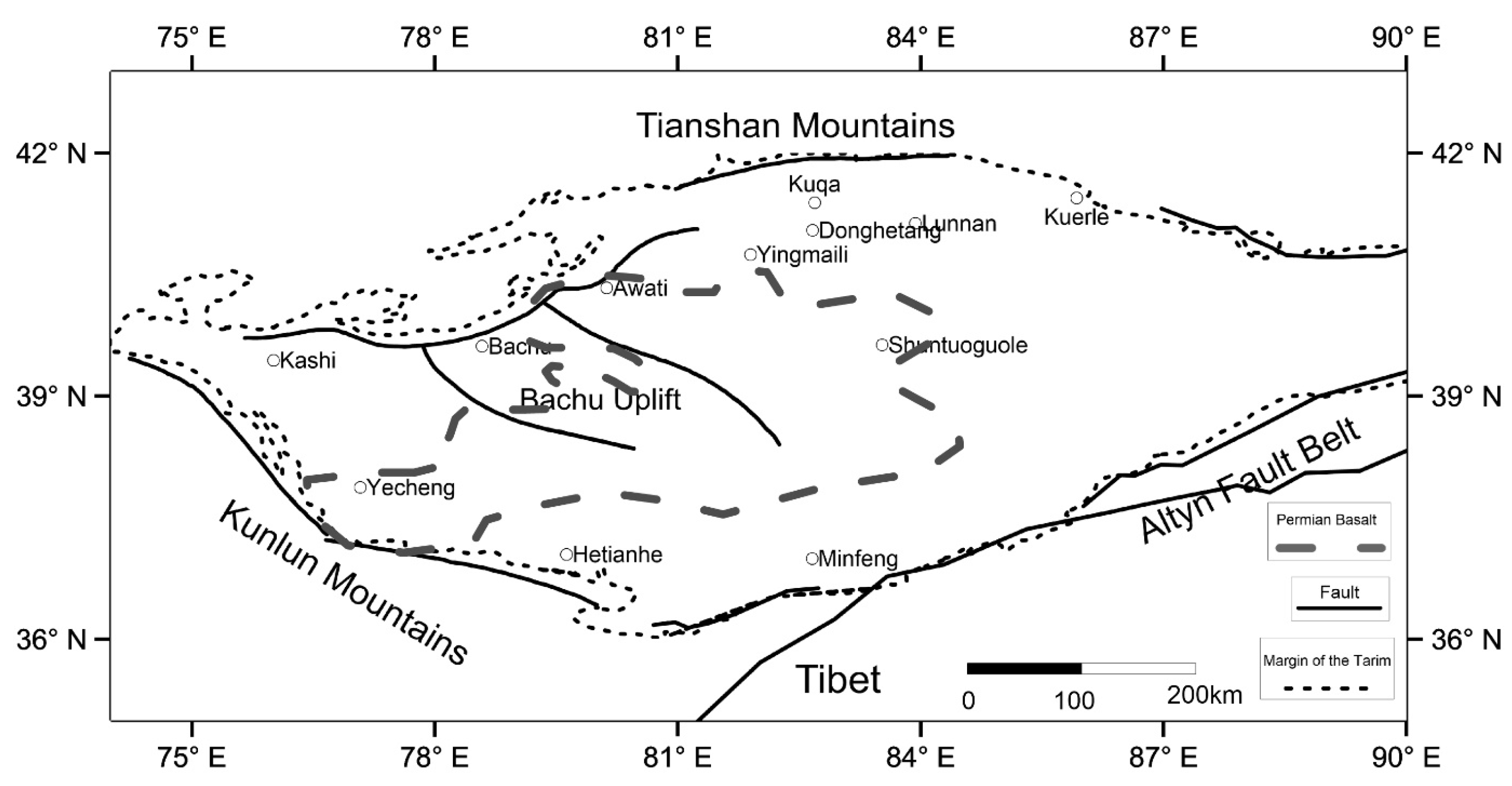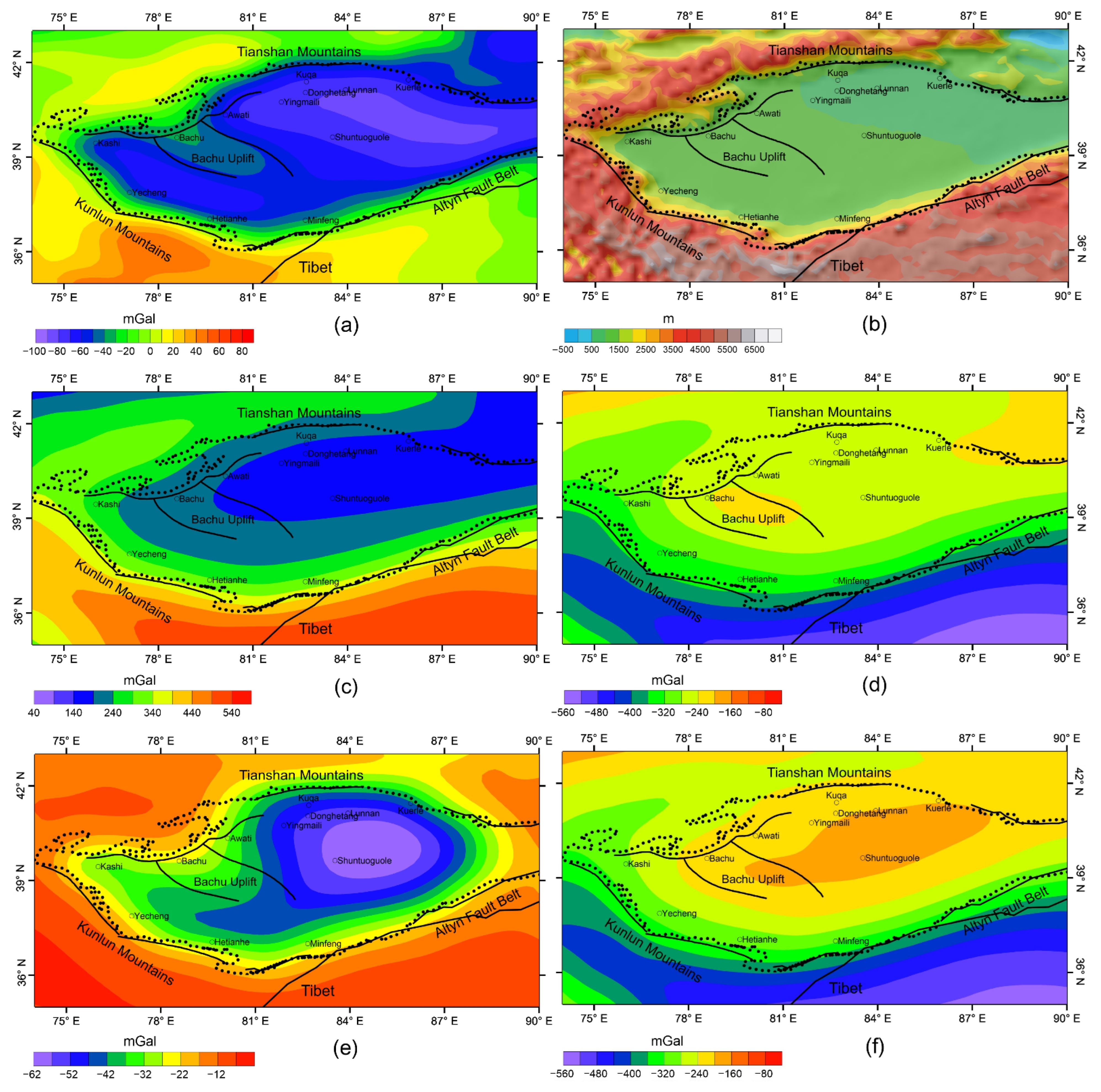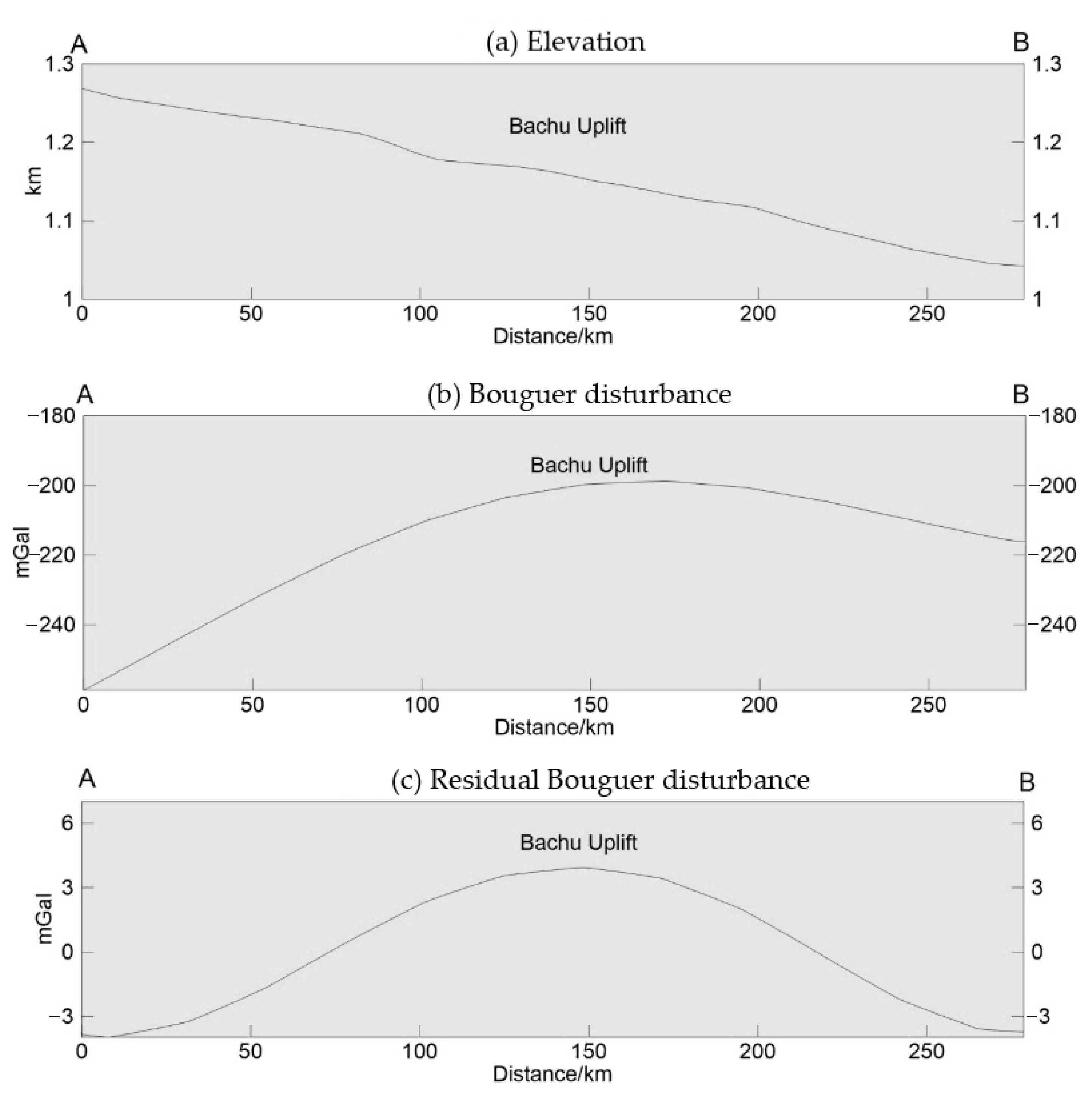Analysis of Regional and Residual Gravity Disturbance of Major Fault Belts in the Tarim Basin, Western China
Abstract
:1. Introduction
2. Data and Method
2.1. Geological Overview of the Tarim Basin
2.2. Data
2.3. Method
3. Results
3.1. Bouguer Disturbance after Separation
3.2. Bouguer Disturbance Corrected from Sediment after Separation
4. Discussion
4.1. Tianshan Orogen
4.2. West Kunlun Orogen
4.3. Altyn Fault Zone
4.4. Bachu Uplift
5. Conclusions
- (1)
- The residual disturbance shows two linear disturbance zones, positive and negative disturbance zones, on both sides of the Altyn fault and the Tianshan fault belt respectively. The linear residual disturbance zones of the Tianshan Mountains trend toward the ENE direction and the linear residual disturbance zones of the Altyn trend toward the NE direction, which is consistent with the stretching direction of their related fault belts;
- (2)
- The linear positive residual disturbance zone in the West Kunlun Mountains appears an observable discontinuity, which coincides with the spatial distribution of the fault belt of the West Kunlun. The discontinuity divides the linear residual disturbance into two parts, the northwest part trending in the NW direction and the southeast part trending in the WNW direction;
- (3)
- The regional Bouguer disturbance is related to the depth of the crust–mantle boundary. Although regional disturbance cannot precisely identify the depth of the crust–mantle boundary, it can roughly estimate the crust thickness. The regional Bouguer disturbance suggests the depth order of crust–mantle boundary from deep to shallow is the Altyn region, the West Kunlun, and Tianshan Mountains, which is proved by the previous seismic study by seismic precise measurement;
- (4)
- The residual disturbance can estimate the position and boundary of the Bachu, Tanan, Tabei, Tadong, and Kuluketage uplifts by exhibiting central positive disturbance with an elliptical shape.
Author Contributions
Funding
Data Availability Statement
Acknowledgments
Conflicts of Interest
References
- Carroll, A.; Graham, S.; Hendrix, M.; Ying, D.; Zhou, D. Late Paleozoic tectonic amalgamation of northwestern China: Sedimentary record of the northern Tarim, northwestern Turpan, and southern Junggar basins. Geol. Soc. Am. Bull. 1995, 107, 571–594. [Google Scholar] [CrossRef]
- Clark, M.K.; Royden, L.H. Topographic ooze: Building the eastern margin of Tibet by lower crustal flow. Geology 2000, 28, 703–706. [Google Scholar] [CrossRef]
- Braitenberg, C.; Wang, Y.; Fang, J.; Hsu, H. Spatial variations of flexure parameters over the Tibet-Quinghai plateau. Earth Planet. Sci. Lett. 2003, 205, 211–224. [Google Scholar] [CrossRef]
- Zhang, P.Z.; Deng, Q.D.; Yang, X.P. Late Cenozoic tectonic deformation and mechanism along the Tianshan Mountain, Northwestern China. Earthq. Res. China 1996, 12, 127–140. [Google Scholar]
- Molnar, P.; Tapponnier, P. Cenozoic tectonics of Asia: Effects of a continental collision. Science 1975, 189, 419–426. [Google Scholar] [CrossRef]
- Tapponnier, P.; Molnar, P. Active faulting and tectonics in China. J. Geophys. Res. 1977, 82, 2905–2930. [Google Scholar] [CrossRef]
- Tapponnier, P.; Peltzer, G.; Armijo, R. On the mechanics of the collision between India and Asia. Geol. Soc. Lond. Spec. Publ. 1986, 19, 113–157. [Google Scholar] [CrossRef]
- Yin, A.; Nie, S. 20 A Phanerozoic palinspastic reconstruction of China and its neighboring regions. In The Tectonic Evolution of Asia; Cambridge University: New York, NY, USA, 1996. [Google Scholar]
- Neil, E.A.; Houseman, G.A. Geodynamics of the Tarim Basin and the Tian Shan in central Asia. Tectonics 1997, 16, 571–584. [Google Scholar] [CrossRef]
- Kaban, M.K.; Yuanda, T.R. Density structure, isostatic balance and tectonic models of the Central Tien Shan. Surv. Geophys. 2014, 35, 1375–1391. [Google Scholar] [CrossRef]
- Huang, B.; Piper, J.D.; Peng, S.; Liu, T.; Li, Z.; Wang, Q.; Zhu, R. Magnetostratigraphic study of the Kuche Depression, Tarim Basin, and Cenozoic uplift of the Tian Shan range, western China. Earth Planet. Sci. Lett. 2006, 251, 346–364. [Google Scholar] [CrossRef]
- Lin, C.; Yang, H.; Liu, J.; Rui, Z.; Cai, Z.; Zhu, Y. Distribution and erosion of the Paleozoic tectonic unconformities in the Tarim Basin, Northwest China: Significance for the evolution of paleo-uplifts and tectonic geography during deformation. J. Asian Earth Sci. 2012, 46, 1–19. [Google Scholar] [CrossRef]
- Jia, C.; Yao, H.; Wei, G.; Wei, L.; Jia, C.; Yao, H.; Wei, G.; Wei, L. Plate tectonic evolution and characteristics of major tectonic units of the Tarim basin. Tarim Basin 1991, 3, 207–225. (In Chinese) [Google Scholar]
- Ren, J.; Zhang, J.; Yang, H.; Hu, D.; Li, P.; Zhang, Y. Analysis of fault systems in the Central uplift, Tarim Basin. Acta Petrol. Sin. 2011, 27, 219–230. [Google Scholar]
- Guo, J.; Li, W.; Chang, X.; Zhu, G.; Liu, X.; Guo, B. Terrestrial water storage changes over Xinjiang extracted by combining Gaussian filter and multichannel singular spectrum analysis from GRACE. Geophys. J. Int. 2018, 213, 397–407. [Google Scholar] [CrossRef]
- Zhang, C.-L.; Zou, H.-B.; Li, H.-K.; Wang, H.-Y. Tectonic framework and evolution of the Tarim Block in NW China. Gondwana Res. 2013, 23, 1306–1315. [Google Scholar] [CrossRef]
- Gao, R.; Hou, H.; Cai, X.; Knapp, J.H.; He, R.; Liu, J.; Xiong, X.; Guan, Y.; Li, W.; Zeng, L. Fine crustal structure beneath the junction of the southwest Tian Shan and Tarim Basin, NW China. Lithosphere 2013, 5, 382–392. [Google Scholar] [CrossRef]
- Guo, Z.-J.; Yin, A.; Robinson, A.; Jia, C.-Z. Geochronology and geochemistry of deep-drill-core samples from the basement of the central Tarim basin. J. Asian Earth Sci. 2005, 25, 45–56. [Google Scholar] [CrossRef]
- Mi, N.; Wang, L.; Li, H.; Xu, M.; Chen, Y.; Li, C.; Zhang, Y.; Yu, D. Velocity structure of the crust and uppermost mantle in the boundary area of the Tianshan Mountains and the Tarim Basin. Chin. Sci. Bull. 2005, 50, 270–275. [Google Scholar] [CrossRef]
- Zhao, J.; Cheng, H.; Pei, S.; Liu, H.; Zhang, J.; Liu, B. Deep structure at northern margin of Tarim Basin. Chin. Sci. Bull. 2008, 53, 1544–1554. [Google Scholar] [CrossRef]
- Lin, C.; Liu, J.; Eriksson, K.; Yang, H.; Cai, Z.; Li, H.; Yang, Z.; Rui, Z. Late Ordovician, deep-water gravity-flow deposits, palaeogeography and tectonic setting, Tarim Basin, Northwest China. Basin Res. 2014, 26, 297–319. [Google Scholar] [CrossRef]
- Gao, Z.; Wang, L.; Tian, W.; Gong, M. 3-D Seismology Interpretation and Structure Analysis of Early Permian Flood Basalt Volcanic Edifices in Tarim Basin. Beijing Da Xue Xue Bao 2018, 54, 555–562. [Google Scholar]
- Deng, Y.; Levandowski, W.; Kusky, T. Lithospheric density structure beneath the Tarim basin and surroundings, northwestern China, from the joint inversion of gravity and topography. Earth Planet. Sci. Lett. 2017, 460, 244–254. [Google Scholar] [CrossRef]
- Xu, M.-J.; Liang, S.W.; Kai, Z.; De-Zhao, H.; Hua, L.; Xu, Z.H. Features of gravitational and magnetic fields in the Tarim basin and basement structure analysis. Geol. J. China Univ. 2005, 11, 585. [Google Scholar]
- Förste, C.; Bruinsma, S.; Abrikosov, O.; Lemoine, J.-M.; Marty, J.C.; Flechtner, F.; Balmino, G.; Barthelmes, F.; Biancale, R. EIGEN-6C4: The latest combined global gravity field model including GOCE data up to degree and order 2190 of GFZ Potsdam and GRGS Toulouse. GFZ Data Serv. 2014, 16, 2014–3707. [Google Scholar]
- Xu, Y.; Hao, T.; Li, Z.; Duan, Q.; Zhang, L. Regional gravity anomaly separation using wavelet transform and spectrum analysis. J. Geophys. Eng. 2009, 6, 279–287. [Google Scholar] [CrossRef]
- Li, Y.; Braitenberg, C.; Yang, Y. Interpretation of gravity data by the continuous wavelet transform: The case of the Chad lineament (North-Central Africa). J. Appl. Geophys. 2013, 90, 62–70. [Google Scholar] [CrossRef]
- Wang, W.; Qiu, Z.; Liu, J.; Huang, Y.; Yu, C.; Li, H. The research to the extending edge and interpolation based on the minimum curvature method in potential field data processing. Prog. Geophys. 2009, 19, 298–304. [Google Scholar]
- Mickus, K.L.; Aiken, C.L.; Kennedy, W. Regional-residual gravity anomaly separation using the minimum-curvature technique. Geophysics 1991, 56, 279–283. [Google Scholar] [CrossRef]
- Ghaderpour, E.; Ince, E.S.; Pagiatakis, S.D. Least-squares cross-wavelet analysis and its applications in geophysical time series. J. Geod. 2018, 92, 1223–1236. [Google Scholar] [CrossRef]
- Briggs, I.C. Machine contouring using minimum curvature. Geophysics 1974, 39, 39–48. [Google Scholar] [CrossRef]
- Yang, M.; Wang, W.-Y.; Du, X.-D.; Fang, Y.; Zhang, K. Tectonic districts by satellite gravity data of the Bone basin, Sulawesi, Indonesia. Prog. Geophys. 2016, 31, 999–1009. [Google Scholar]
- Ma, J.; Wang, W.; Ji, X.; Amp, G.; University, C. Tectonic Characteristics of Cesar Basin and Its Adjacent Areas According to Gravity Field. Geol. Sci. Technol. Inf. 2019, 38, 285–294. [Google Scholar] [CrossRef]
- Zhou, H.; Zhou, Z.; Luo, Z. A new hybrid processing strategy to improve temporal gravity field solution. J. Geophys. Res. Solid Earth 2019, 124, 9415–9432. [Google Scholar] [CrossRef]
- Feng, B.; Zhou, Y.; Chi, S.; Yang, T.; Zhong, C.; Ye, S. Pre-Sinian Geology and Noble Metals, Colored Metals Mineralization in Quruqtagh, Xinjiang; Geological Publishing House: Beijing, China, 1995. [Google Scholar]
- Lu, S.; Li, H.; Zhang, C.; Niu, G. Geological and geochronological evidence for the Precambrian evolution of the Tarim Craton and surrounding continental fragments. Precambrian Res. 2008, 160, 94–107. [Google Scholar] [CrossRef]
- Tang, L.J. Evolution and Tectonic Patterns of Tarim Basin. Earth Sci. J. China Univ. Geosci. 1994, 19, 742–754. [Google Scholar]
- He, D.; Zhou, X.; Zhang, C.; Yang, W.; Shi, X. Characteristics of geologic framework of multicycle superimposed basin in Tarim Basin. China Pet. Explor. 2006, 11, 31–41. [Google Scholar]
- Li, Z.; Roecker, S.; Zhihai, L.; Bin, W.; Haitao, W.; Schelochkov, G.; Bragin, V. Tomographic image of the crust and upper mantle beneath the western Tien Shan from the MANAS broadband deployment: Possible evidence for lithospheric delamination. Tectonophysics 2009, 477, 49–57. [Google Scholar]
- Sobel, E.R.; Arnaud, N. Cretaceous–Paleogene basaltic rocks of the Tuyon basin, NW China and the Kyrgyz Tian Shan: The trace of a small plume. Lithos 2000, 50, 191–215. [Google Scholar] [CrossRef]
- Zou, T.; Cao, Y.; Xu, J.; Yu, X.; Xia, F.; Chen, W. Geology and geochemistry of the Cenozoic alkaline basalt on the northern margin of the Tarim basin, Xinjiang, China. Geol. Rev. 1999, 45, 1072–1077. [Google Scholar]
- Ding, W.; Lin, C.; Qi, L.; Huang, T.; Yu, T. Structural framework and evolution of Bachu uplift in Tarim basin. Earth Sci. Front. 2008, 15, 242–252. [Google Scholar]
- Andersen, O.B.; Knudsen, P.; Berry, P.A. The DNSC08GRA global marine gravity field from double retracked satellite altimetry. J. Geod. 2010, 84, 191–199. [Google Scholar] [CrossRef]
- Pavlis, N.K.; Holmes, S.A.; Kenyon, S.C.; Factor, J.K. The development and evaluation of the Earth Gravitational Model 2008 (EGM2008). J. Geophys. Res. Solid Earth 2012, 117. [Google Scholar] [CrossRef]
- Laske, G. A global digital map of sediment thickness. Eos Trans. AGU 1997, 78, F483. [Google Scholar]
- Laske, G.; Masters, G.; Ma, Z.; Pasyanos, M. CRUST1. 0: An updated global model of Earth’s crust. Geophys. Res. Abs. 2012, 14, 743. [Google Scholar]
- Bao, X.; Song, X.; Li, J. High-resolution lithospheric structure beneath Mainland China from ambient noise and earthquake surface-wave tomography. Earth Planet. Sci. Lett. 2015, 417, 132–141. [Google Scholar] [CrossRef]
- Huang, T.; Chi-Shun, J.; Chih-Meng, J.C.F.C.; Zhi-Qin, X. An outline of the tectonic characteristics of China. Acta Geol. Sin. 1977, 36, 288–303. [Google Scholar]
- Sobel, E.R.; Dumitru, T.A. Thrusting and exhumation around the margins of the western Tarim basin during the India-Asia collision. J. Geophys. Res. Solid Earth 1997, 102, 5043–5063. [Google Scholar] [CrossRef]
- Thompson, S.C.; Weldon, R.J.; Rubin, C.M.; Abdrakhmatov, K.; Molnar, P.; Berger, G.W. Late Quaternary slip rates across the central Tien Shan, Kyrgyzstan, central Asia. J. Geophys. Res. Solid Earth 2002, 107, ETG 7-1–ETG 7-32.
- Sobel, E.R.; Chen, J.; Heermance, R.V. Late Oligocene–Early Miocene initiation of shortening in the Southwestern Chinese Tian Shan: Implications for Neogene shortening rate variations. Earth Planet. Sci. Lett. 2006, 247, 70–81. [Google Scholar] [CrossRef]
- Lei, J. Seismic tomographic imaging of the crust and upper mantle under the central and western Tien Shan orogenic belt. J. Geophys. Res. Solid Earth 2011, 116. [Google Scholar] [CrossRef]
- Allen, M.B.; Vincent, S.J.; Wheeler, P.J. Late Cenozoic tectonics of the Kepingtage thrust zone: Interactions of the Tien Shan and Tarim Basin, northwest China. Tectonics 1999, 18, 639–654. [Google Scholar] [CrossRef]
- Chen, J.; Ding, G.; Burbank, D.; Scharer, K.; Rubin, C.; Sobel, E.; Qu, G.; Shen, J.; Yin, J.; Zhao, R. Late Cenozoic tectonics and seismicity in the southwestern Tian Shan, China. Earthq. Res. China 2001, 17, 134–155. [Google Scholar]
- Shao, X.; Zhang, J. Preliminary Results of Study of Deep Structures in Tarim Basin by the Method of Converted Waves of Earthquakes. Chin. Sci. Abstr. Ser. B 1995, 1995, 60. [Google Scholar]
- Wang, S.; Shi, Z.; Huan, W. The Yecheng, Xinjiang, China, earthquake of 14 February 1980. Acta Seismol. Sin. 1992, 5, 675–682. [Google Scholar] [CrossRef]
- Cowgill, E.; Yin, A.; Harrison, T.M.; Xiao-Feng, W. Reconstruction of the Altyn Tagh fault based on U-Pb geochronology: Role of back thrusts, mantle sutures, and heterogeneous crustal strength in forming the Tibetan Plateau. J. Geophys. Res. Solid Earth 2003, 108. [Google Scholar] [CrossRef]
- Shi, D. Crust and upper mantle tomographic structure across the Altyn fault zone using teleseismic P-waves. Chin. J. Geophys. 1999, 42, 341–350. [Google Scholar]
- Jia, C.; Wei, G. Structural characteristics and petroliferous features of Tarim Basin. Chin. Sci. Bull. 2002, 47, 1–11. [Google Scholar] [CrossRef]
- Xu, Y.-G.; Wei, X.; Luo, Z.-Y.; Liu, H.-Q.; Cao, J. The Early Permian Tarim Large Igneous Province: Main characteristics and a plume incubation model. Lithos 2014, 204, 20–35. [Google Scholar] [CrossRef]





Publisher’s Note: MDPI stays neutral with regard to jurisdictional claims in published maps and institutional affiliations. |
© 2022 by the authors. Licensee MDPI, Basel, Switzerland. This article is an open access article distributed under the terms and conditions of the Creative Commons Attribution (CC BY) license (https://creativecommons.org/licenses/by/4.0/).
Share and Cite
Wu, Y.; Liang, F.; Yan, J.; Pei, J.; Zhang, Y. Analysis of Regional and Residual Gravity Disturbance of Major Fault Belts in the Tarim Basin, Western China. Remote Sens. 2022, 14, 3948. https://doi.org/10.3390/rs14163948
Wu Y, Liang F, Yan J, Pei J, Zhang Y. Analysis of Regional and Residual Gravity Disturbance of Major Fault Belts in the Tarim Basin, Western China. Remote Sensing. 2022; 14(16):3948. https://doi.org/10.3390/rs14163948
Chicago/Turabian StyleWu, Yunlong, Feng Liang, Jianguo Yan, Junling Pei, and Yi Zhang. 2022. "Analysis of Regional and Residual Gravity Disturbance of Major Fault Belts in the Tarim Basin, Western China" Remote Sensing 14, no. 16: 3948. https://doi.org/10.3390/rs14163948
APA StyleWu, Y., Liang, F., Yan, J., Pei, J., & Zhang, Y. (2022). Analysis of Regional and Residual Gravity Disturbance of Major Fault Belts in the Tarim Basin, Western China. Remote Sensing, 14(16), 3948. https://doi.org/10.3390/rs14163948






